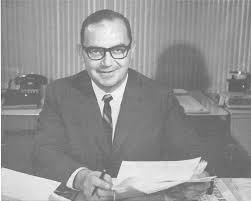“NOAA is now positioned to advance United States in an environmentally sustainable manner. And that is the central problem of the 21st century.” – R. M. White (2005).
Robert M. White, Chief of the U.S. Weather Bureau from 1963-1965, director of the Environmental Services Administration, 1965-1970, and first NOAA Administrator 1970-1977, passed away this morning at the age of 92.
One of the last executive appointments made by President John F. Kennedy prior to his tragic assassination? Kept on by President Lyndon Johnson and then appointed the first NOAA administrator by President Richard Nixon, a Republican? Retained for seven full years by Nixon and subsequently by President Gerald Ford? You don’t have to know any more to recognize that Bob White was someone special.
And yet there’s so much more to his career. He served in the military during World War II. After earning a meteorology Ph.D. from MIT he carved out a distinguished career in private-sector meteorology at Travelers Corporation, working for Thomas F. Malone (Tom Malone was Robert White’s mentor, if you can imagine such a thing; read Mr. Malone’s bio and you’ll understand how that all came about) – this during a period when such private-sector work was much less common. He chaired the first World Climate Conference in 1979 (think of this as a forerunner of the current series of UN conferences on Climate Change). When he stepped down from NOAA he quickly assumed the Presidency of the University Corporation for Atmospheric Research. He led UCAR/NCAR from a Washington, DC office (the first and only President to do so), over the period 1980-1983. In 1983 he left UCAR to become President of the National Academy of Engineering, which he led for twelve years (two terms) before stepping down in 1995.
Retirement? No, Robert White, then 72, wasn’t close to done. In that year he founded and became the founding president of the Washington Advisory Group (WAG; yes, the acronym was intentional) along with other senior science-policy officials who had become close friends and colleagues over his career: D. Allan Bromley, Frank Press, Erich Bloch (former NSF Director), Robert Frosch, and a handful of lesser lights. For fourteen years, these folks would consult with universities, major corporations, and other clients, helping them solve their science-policy challenges, commanding handsome fees. When the work became less fun, they sold their practice to others, in 2010.
Awards and honors? A fistful. If you want a hint of that, and more background to the merest sketch provided here, you might check out the text of a talk Mr. White gave to an evening audience at the National Air and Space Museum in December of 2005.
But Bob wants most a different kind of recognition from you and me, whether we work directly for NOAA or whether we’re part of that much larger swarm of collaborators: the people who work with NOAA and help use forecasts and outlooks to harness the world’s resources, or mitigate natural hazards, or protect the environment and ecosystems. He wants us to play our respective parts in helping fulfill his last forecast, embodied in his closing sentence to that 2005 talk:
“NOAA is now positioned to advance United States in an environmentally sustainable manner. And that is the central problem of the 21st century.”
He wants us to take fullest advantage of that position to solve that central problem.
Rest in (well-earned!) peace, Bob. We’re on it.


Excellent retrospective Bill.
Thanks Bill for your wonderful reflections and tributes to Bob and Jim. Society, and our sciences are much the richer because of their lives and service.